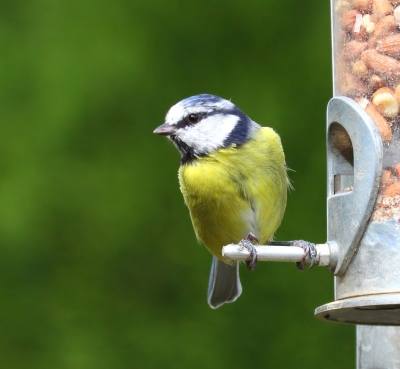
You can stop birds from flying into windows
by Debra Firmani
Once you have heard it, you will never forget the sound—the sickening “thud” of a bird hitting glass. Then you go outside, dreading the sight of a beautiful winged creature lying motionless on the ground beneath a window. You don't know what do to help her. And you wish you could stop this from happening ever again. You can.
The first step is to understand why birds fly into windows: It's usually because when they're looking at the window, they're seeing the reflection of sky or trees instead of a pane of glass. They think they're following a clear flight path. That mistake can be deadly; at least half of the birds who hit windows die from their injuries or because another animal killed them while they were stunned and couldn't escape or protect themselves.
Now you're ready to prevent the next collision.
Make windows visible to birds
Change things outside
- Window screen or a light net: Attach this at least 2-3” from the window. When the screen or net is taut, birds will bounce off (imagine a trampoline) without getting caught.
- CollidEscape film: Apply the film to the outside—not the inside—of your window. It'll be transparent to you, but opaque to birds.
- Tape strips: Attach strips of chart tape on outside of window—either 1/4” vertical white strips (spaced 4” apart) or 1/8” horizontal black strips (spaced an inch apart).
- External shutters: Close them whenever windows aren't in use.
- External sun shades or awnings: They will eliminate or minimize reflection and transparency.
- Soap or paint patterns: Paint patterns on the outsides of windows with soap or tempera paint (which can be wiped off with a sponge but will won't be washed away by rain). You can find stencils and tempera paint at art and craft supply stores.
- Decals and Wing Chimes: Place them closely together so that the spaces between them are no more than a 4” wide by 2” high. You can find decals at art and craft supply stores.
- Move feeders and baths: Place bird feeders and baths either within 3 feet (too close for a collision to be fatal) of windows or more than 30 feet away (birds will be more likely to recognize that windows are a part of the house).
- Bug screens year-round: If you have modern dual-pane windows, you can leave screens up all year to provide cushioning if a bird hits the window.
- Whitewash: If your shed or basement has windows, consider whitewashing them.
Change things inside
- Vertical blinds: Keep these halfway (or more) closed.
- Shades and curtains: If you you aren't looking out the window or don't need to let in daylight, keep these closed.
- Lights: At night, turn off lights or else close curtains or blinds.
Think "bird-safe" when you build or remodel
- Fritted glass windows: The closely spaced dots of opaque glass fused on the outer surface makes them highly visible to birds, but you can still see through them.
- Angled glass: If you position windows downward (20 degrees), the glass won't reflect sky and trees.
- UV-reflective glass: UV-reflective glass, such as Ornilux is visible to birds and transparent to humans
- Etched or sandblasted windows: You can have any pattern etched or sandblasted onto the glass. (This is most effective if the areas that don't have a pattern are no more than 4” wide or more than 2” high.
How to help a bird who has flown into a window
- Gently cover and catch the bird with a towel and place her in a paper bag or cardboard box (with air holes) that is securely closed.
- Keep the bird in a quiet, warm, dark place, away from activity.
- Check on the bird every 30 minutes. But don't touch the bird.
- If the bird seems to recover, carry the container outside and open it. Then step back, remain quiet, and see if the bird flies away. If she doesn't fly away, carefully take her back inside.
- If the bird doesn't recover within a few hours, but is still breathing, contact a wildlife rehabilitator. You can find one by calling your local animal shelter, veterinarian, or state Division of Natural Resources. An online resource is Wildlife International.
Resources
Other sites
Cornell Lab of Ornithology
American Bird Conservancy
Fatal Light Awareness Project
National Audubon Society
Birds and Buildings Forum
Products
The Bird Screen Company (screens)
Large Format Digital CollidEscape (window film)
Acopian Bird Savers (hanging cords and DIY instructions)
Ornilux Bird Protection Glass (UV reflective coated glass)
Magnatag Visible Systems (chart tape)
Article Courtesy of: http://www.humanesociety.org
Image Courtesy of: Paul Brentnall

